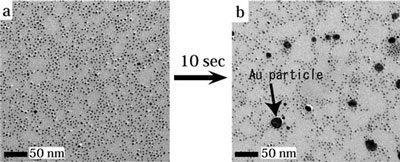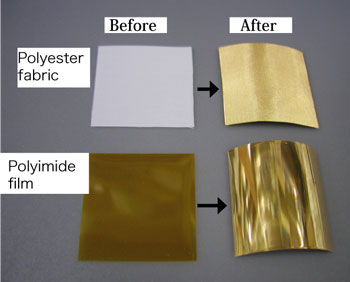| Posted: November 5, 2008 |
Environment-friendly gold plating with high adhesion to various plastic films |
|
(Nanowerk News) Shin Horiuchi and Yukimichi Nakao from the the Research Group for Nanoscientific Measurements at the Nanotechnology Research Institute of the National Institute of Advanced Industrial Science and Technology (AIST) in Japan have developed a novel cyan-free electroless gold plating reaction providing excellent adhesion to various plastic materials.
|
|
Electroless plating is one of the important technologies in industry. It has been introduced in the production processes for electronic devices (print circuit boards, etc.), automobile parts (hubcaps and steering wheels, etc.), and office equipments, etc. as a metal coating and deposition techniques of insulating material such as plastic and complex shaped products. Gold plated films have attractive features in terms of its excellent electrical conductivity, low contact resistance, corrosion resistance, solderability, abrasion resistance, and light reflection. Conventional electroless gold plating, however, requires the use gold cyanide, causing problems related to the management of toxic substances and environmental pollution. Also, complicated pre-processing is necessary to achieve high adhesion to base substrate.
|
|
After the discover of a novel cyan-free electroless gold plating reaction two years ago, we have been improving this method to achieve high adhesion and first deposition at room temperature by introducing an originally developed platinum colloid catalyst system.
|
|
Details of this research are to be announced at the 57th Symposium on Macromolecules held at Osaka Prefecture University on September 26, 2008. Moreover, the method will be demonstrated as "Applications of Colloidal Metals" at the AIST Open Lab held at AIST Tsukuba on October 20 and 21, 2008.
|
|
Background for Research
|
|
Electroless plating is a chemical deposition process in which metal is deposited on insulating substrate and complex shapes materials without the use of electricity. Gold electroless plating is in particular important due to its various excellent characteristics.
|
|
Highly toxic gold cyanide has been used as one of the raw materials for conventional electroless gold plating, causing risks on the working and global environments. Moreover, physical treatment methods using expensive vacuum apparatus, such as plasma treatment, or chemical treatment methods using the dangerous oxidant have been employed for surface treatments necessary to obtain adhesion of plated films. In addition, complex process was required for the deposition of palladium used as a catalyst.
|
|
History of Research
|
|
The Research Group for Nanoscientific Measurements, the Nanotechnology Research Institute of AIST has been investigated the interaction between various metallic nanoparticles and polymers by means of electron microscopy and surface spectroscopy, resulting in extensive accumulation of knowledge. In this context, we discovered a technique for the fixation of noble metal nanoparticles on polymer surfaces, and developed it as a catalyst system for a novel electroless gold plating.
|
|
Details of Research
|
|
In electroless plating, a catalyst was deposited on the surface of insulating material, such as plastics or ceramics, and the metal thin film is formed by chemical reduction of metal ions in the plating solution. In this research, a platinum colloid where platinum nanoparticles with a few nm (nanometer) in diameter were suspended in water was used as a catalyst. In this platinum colloid, uniform platinum nanoparticles of about 3 nm in diameter protected with a polymer are stably dispersed in water. When a base material, such as plastic, is soaked in this solution, the platinum nanoparticles can be uniformly fixed on the surface of the material. We found that hydrogen peroxide reduced the chloroauric acid with the catalytic ability of platinum nanoparticles when the base material was soaked in the aqueous solution of hydrogen peroxide of low concentration and chloroauric acid. Then, we have developed a safe, convenient electroless gold plating method that did not use cyanide compound.
|
|
The small gold particles with about 50nm diameter are produced on the fixed platinum nanoparticles, the number of the gold particles increases with the plating time, and finally the continuous film is formed. The reduction reaction of the gold ions is believed to progress by the catalysis of the platinum nanoparticles fixed on the base material as the following chemical equation:
|
 |
|
This reaction takes place at room temperature and the continuous gold film can be obtained within a few minutes owing to the excellent catalytic property of the platinum nanoparticles. Moreover, we found that adhesion of the plating film was dramatically improved only by annealing for about 30 minutes at the temperatures ranging from 100?C to 250?C, depending on the properties of used plastics after plating. The adhesion strength was evaluated by the scotch tape test according to JIS K5600-5-6. The gold plated films were not peeled off from plastic films after annealing. Thus, strong adhesion of the gold plated films to plastic films can be ensured without using special chemicals or physical pre-treatments. It has been confirmed that the method provides gold plated films with high adhesion to various plastics such as polyethylene, polypropylene, nylon, polyester, polyimides, and polycarbonates. The method can be also applied to rubbers, ceramics, glass, and carbon materials.
|
 |
| TEM micrographs showing (a) Pt nanoparticles fixed on carbon thin film and (a) gold particles deposited on the Pt nanoparticles.
|
 |
| Appearances before and after the gold electroless plating on polyester fabric and polyimide film.
|
|
Future Plans
|
|
The cyan-free electroless gold plating method developed in this research is an energy-saving and environment-friendly process because it is free of toxic substances and can be employed at room temperature. The method produces excellent gold plated films with good adhesion to various substrates of insulating materials and complex shaped products. It is also possible to make beautiful gold threads by applying the method to fiber such as polyester. We hope to find applications of this technique through the corporations with companies in various fields. Moreover, we will investigate the mechanisms of catalyst of the platinum colloid and the adhesion improvement, as well as to develop electroless plating of other metals.
|



